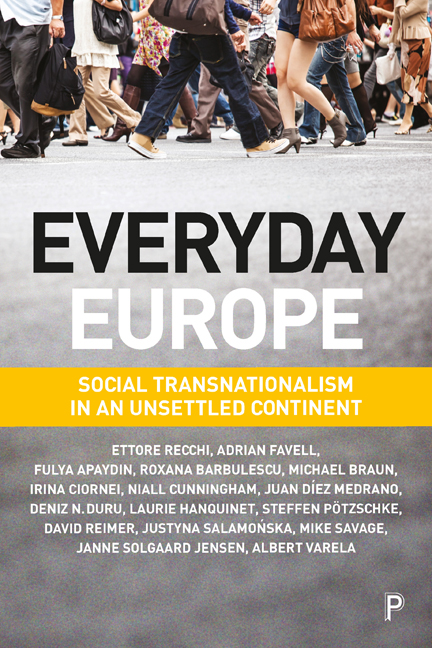Book contents
- Frontmatter
- Contents
- List of tables and figures
- Notes on contributors
- Acknowledgements
- Introduction: Social transnationalism in an unsettled continent
- one Cartographies of social transnationalism
- two The social structure of transnational practices
- three Cultural boundaries and transnational consumption patterns
- four Social transnationalism and supranational identifications
- five Explaining supranational solidarity
- six Narratives and varieties of everyday transnationalism
- seven Understanding Romanians’ cross-border mobility in Europe: movers, stayers and returnees
- eight Transnational Turkey: the everyday transnationalism and diversity of Turkish populations in Europe
- Epilogue Is social transnationalism fusing European societies into one?
- Methodological appendix
- Index
two - The social structure of transnational practices
Published online by Cambridge University Press: 19 April 2022
- Frontmatter
- Contents
- List of tables and figures
- Notes on contributors
- Acknowledgements
- Introduction: Social transnationalism in an unsettled continent
- one Cartographies of social transnationalism
- two The social structure of transnational practices
- three Cultural boundaries and transnational consumption patterns
- four Social transnationalism and supranational identifications
- five Explaining supranational solidarity
- six Narratives and varieties of everyday transnationalism
- seven Understanding Romanians’ cross-border mobility in Europe: movers, stayers and returnees
- eight Transnational Turkey: the everyday transnationalism and diversity of Turkish populations in Europe
- Epilogue Is social transnationalism fusing European societies into one?
- Methodological appendix
- Index
Summary
Introduction
Globalisation entails the expansion and diversification of the forms of mobility of humans. Worldwide, technological progress in the fields of communication and transportation has facilitated the development and intensification of new and diverse movements. In Europe, supranational political integration has created a particularly favourable environment for cross-state movements. Since the beginning of the century, social theory has taken into account such major changes with a ‘mobility turn’ (Urry 2000; 2007; Sheller 2016). Empirical research has thus paid renewed and multidisciplinary attention to a large canvas of forms of international mobility centred on Europe: migrations (eg Recchi and Favell 2009; Krings et al 2013; Wiesböck et al 2016); tourism (eg Urry 1990); shopping online (Perea y Monsuwé et al 2004); home ownership and lifestyles abroad (eg Aspden 2005; Wickham 2007; Benson and O’Reilly 2009); and virtual interactions (eg Mau 2010; Larsen et al 2006). In line with a theoretical insight dating back to Karl Deutsch, revived by Jan Delhey (2004) and Neil Fligstein (2008), the scale and intersection of these mobilities across the continent have been studied as the key to ‘horizontal Europeanization’ (Mau and Mewes 2012) and, eventually, to the bottom-up drivers of European integration tout court (Favell and Guiraudon 2009; Kuhn 2015; Recchi 2015). Short of that, mapping individual mobilities is in any case a revealing way of looking at European societies and their hybridisation via social practices.
We operationalise international mobilities as cross-border practices, or ‘behaviours that are performed by any possible individual agent in any aspect of everyday life’ across state frontiers (Favell et al 2011, 19). This chapter will delve into some typical instances of such practices normally studied separately in an integrated way. We start with an a priori classification that guides our selection of relevant indicators of physical and virtual mobilities. We then review existing literature on these forms of mobilities, with a special emphasis on research focused on Europe. In the second part of the chapter, drawing on the EUCROSS dataset, we use survey data on national residents and selected nationalities of migrants (Romanians and Turks) in Denmark, Germany, Italy, Romania, Spain and the United Kingdom, in order to assess the spread of international mobilities in everyday life.
- Type
- Chapter
- Information
- Everyday EuropeSocial Transnationalism in an Unsettled Continent, pp. 61 - 86Publisher: Bristol University PressPrint publication year: 2019

